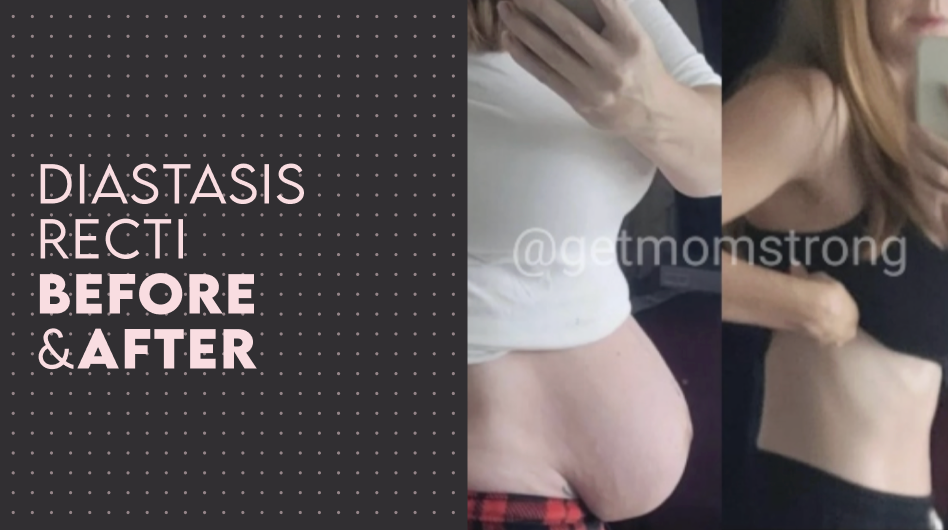I’m always amazed when I hear stories and see photos of my Get Mom Strong mamas healing from diastasis recti (DR). Your progress is a true testament to the resilience of postpartum bodies.
According to the Cleveland Clinic, “[diastasis recti] affects 60% of people. About 40% of those who have diastasis recti still have it by six months postpartum.” It took me several years to heal from diastasis recti after the birth of my twins. It’s never too late to begin the process.
Let’s start with some diastasis recti before and after photos shared by my powerful mamas. It can give you hope! Then we’ll dive into how to measure diastasis recti, DR exercises, causes and how to know if you have it.
Diastasis Recti Before and After:
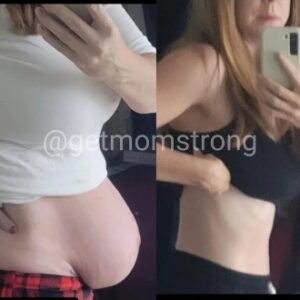
“After I had my 2nd, I was freaking out because I thought my 8 finger separation was here to stay. I still want to get stronger (and get my SLAM booty back ) but I’m proud of my progress. I’ve lost 62lbs, I have more energy, I am more “regular,” and I can run, jump and lift my kids without dying. Your body is amazing, and it is capable of so much, but give it time. It’s felt slow, and the process hasn’t been linear. Some days I’m like, “Eff this. It’s hopeless,” but I always stick with it and eventually see the progress. It took me a year to make this much progress, and 4.5 cumulative years of working on my diastasis to learn what works for my body. The coolest part is that even at 1 year postpartum, I’m still seeing more progress each day.”
– Stephanie F.
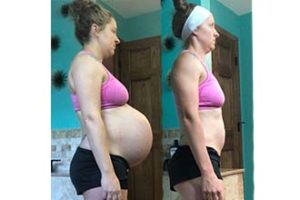
“I was 6 months postpartum with twins and knew what I was doing wasn’t right for my body but I didn’t want to accept it. I just started week 6 of SLAM Advanced! Physically, my DR is functional!! I also don’t look 5 months pregnant anymore. I’m nothing like my pre-baby body, but I feel just as strong as I did before pregnancy. I have more energy and have a new found acceptance for my post baby body and what it can do. Don’t think because you used to work out you can skip around on your program—do the work, it will benefit you in the long run. Also, know it’s okay to get discouraged. I felt very over it all when trying to relearn how to workout and breathe, but I kept saying it will be worth it!”
– Alisha W.
Diastasis Recti Breathing Exercise:
- Inhale: Inhale through your nose, filling your ribs and belly with air.
- Exhale: Exhale through your mouth and make a “haaaa” or “sssss” noise.
- Lift Pelvic Floor: On the exhale, lift your pelvic floor (like a kegel) and then pull your belly button in and up.
I created the video below demonstrating proper diastasis recti breathing exercises:
Abdominal Separation Diastasis Recti Exercises:
Aim to work on core breathing for about 5 minutes in the morning and evening. This will help make proper breathing automatic.
1. Cat Cow
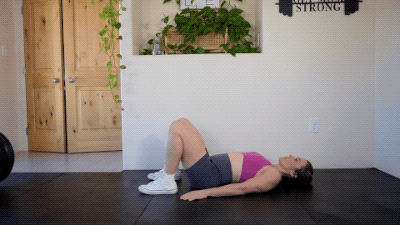
- Get on all fours, with your hands under your shoulders, hips and knees aligned.
- Inhale through your nose into your body as you let your tummy relax, looking toward the ceiling.
- Exhale audibly as you press your palms into the floor, round upper back, and tuck your pelvis.
- Relax and repeat.
2. Knee Roll-Outs (a.k.a. Leg or Hip Openers)
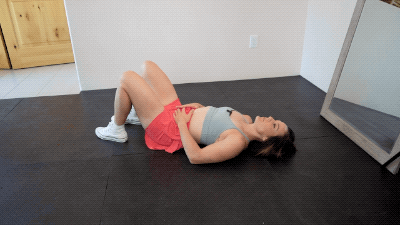
- Lie on your back with your spine in a neutral position, knees bent and feet flat on the floor.
- Inhale through your nose into the body as you slowly lower your right knee to the floor. You should feel your abdominal muscles activate.
- Exhale as you bring the knee back up, pulling your pelvic floor and belly up and in.
- Relax and repeat 5-10 times before switching to the other leg.
3. Pelvic Tilts
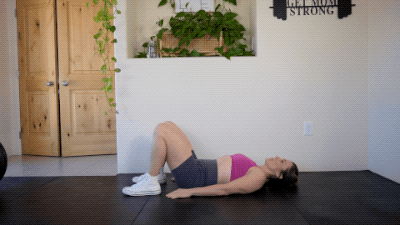
- Lie on your back, with your feet on the ground and legs bent at a 90 degree angle.
- Inhale through your nose, down into your rib cage.
- Exhale audibly out your mouth while you gently tilt your pelvis back.
4. Heel Slides
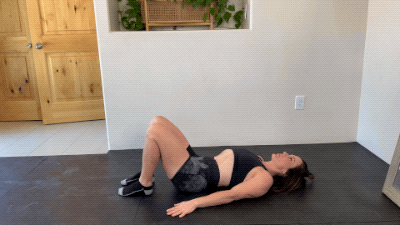
- Lie on your back with a neutral spine, then extend one leg out.
- Inhale through your nose, down into your rib cage.
- Exhale as you slide the heel back in toward your body. Alternate legs.
5. Bridges

- Lie on your back, with your knees bent and feet flat on the floor.
- Inhale through your nose down into your body while your back is on the ground.
- Exhale out your mouth as you rise, lifting your butt off the ground and squeezing your glutes at the top. (Don’t overextend at the top or arch your back!)
- As you relax down, inhale and reset.
What Causes Diastasis Recti?
Diastasis recti occurs when the tissue between the abdominal muscles thins and widens. Pregnancy causes this, as the growing uterus stretches the abdominal wall.
Does Diastasis Recti Cause Bloating?
Yes, diastasis recti can cause bloating.
Often, it isn’t that you are actually bloating more. Rather, your body is showing any bloating occurring much more readily. When the abdominal muscles separate, the abdominal wall weakens. This makes the stomach bulge outward, which looks like bloating.
Diastasis recti can also slow down your digestive process, as the core muscles aid in that process. When these muscles are weak, it can add to bloating as food takes longer to digest.
How Do I Know if I Have Diastasis Recti?
Surprisingly, many doctors don’t check for diastasis recti during your postpartum appointment. Before we assess how to fix it, it’s important to check for diastasis recti to ensure you have it.
Here are some common symptoms of diastasis recti:
- A visible “pooch”
- Coning or doming in the middle of the abdomen
- Lower back pain
- Abdominal discomfort
- Feeling “weak” in your core
How To Check For Diastasis Recti:
- Roll onto your side and then onto your back.
- Bend your knees at a 90-degree angle and keep your feet flat on the floor.
- Relax your tummy completely.
- Place your fingers on your belly button.
- Gently lift your head up about an inch or two.
- Firmly press your fingers down and move them side to side to feel for the abdominal wall.
- Repeat the above step two inches below the belly button, and two inches above.
Final Thoughts on Healing from Diastasis Recti
Healing from diastasis recti is unique to every mama. I love reading the stories and seeing before and after photos of the moms who are healing their core.
The good news is you can improve diastasis recti even years later. I created Get Mom Strong for postpartum moms who want to heal through exercise.
If you’re ready to begin the process of healing diastasis recti, check out my Free 5-Step Core Guide. The guide focuses on healing diastasis recti, incontinence, back and hip pain, prolapse and painful sex.
Don’t forget to sign up for a free trial of my Strong Like A Mother (SLAM) workout program. It’s a no-diet program with health tips from fitness experts and medical professionals for every fitness level.
